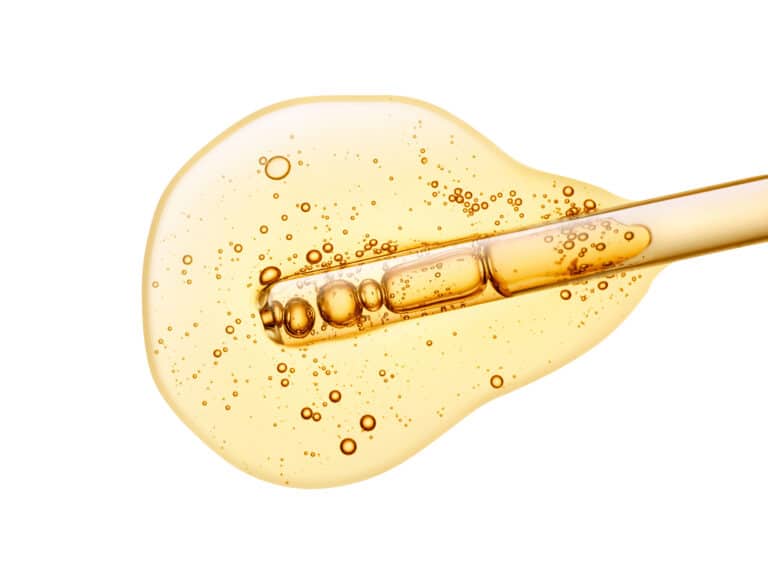Ascorbyl isostearate

Vitamin C (e.g. as stable ascorbyl isostearate) has a number of positive effects on human skin. It inhibits the breakdown of collagen and at the same time stimulates the enzymes responsible for the formation of collagen. As a result, it has a regenerative effect on damaged connective tissue. Furthermore, vitamin C can promote the skin’s natural barrier function and improve the skin’s appearance in the case of impure and/or inflammatory conditions. The use of vitamin C can reduce age and pigmentation spots as it has a lightening effect.
However, as is well known, vitamin C is water-soluble and not very stable. As a result, only small amounts of it enter the skin during cosmetic application. For this reason, manufacturers of cosmetic products prefer to use vitamin C derivatives. They are metabolised directly into ascorbic acid not before they are in the skin, which results in significantly better stability.
One of the frequently used derivatives is fat-soluble ascorbyl palmitate. This is the esterification of ascorbic acid, also known as vitamin C, with the fatty acid palmitic acid, a saturated organic acid. Due to its hydrophilic and lipophilic molecular structure, ascorbyl palmitate is able to penetrate into the deeper layers of the skin. It is an effective antioxidant, but its use is viewed with some scepticism by consumers. The INCI name ‘Ascorbyl Palmitate’ is a cause for discussion on the subject of palm oil.
For the reasons mentioned, Cosmacon favours the use of ascorbyl isostearate for cosmetic products. It has been proven that both vitamin C esters have an equally good effect. Ascorbyl isostearate is therefore a very good alternative to ascorbyl palmitate.
The effect in cosmetic products
The effect of ascorbyl isostearate
Ascorbyl isostearate is a highly oil-soluble vitamin C derivative. Ascorbyl stearate is formed by the condensation of stearoyl chloride and ascorbic acid. Like other derivatives, it is also converted into ascorbic acid in the skin. Due to its strong antioxidant effect and good tolerability, ascorbyl isostearate is a promising antioxidant for skin care, especially in the context of skin ageing, as well as for brightening the skin.
The use of ascorbyl isostearate gives the complexion a plump and elastic radiance. Ascorbyl isostearate also minimises the formation of new wrinkles and reduces their spread. The inhibition of the so-called tyrosinase activity makes it possible to inhibit the formation of new melanin, which can lighten the skin and achieve a more even complexion. Ascorbyl isostearate – like ascorbyl palmitate – also has the property of stimulating collagen formation. Due to its numerous advantages, ascorbyl isostearate offers significant cosmetic benefits, so that its use in anti-ageing products in particular is considered sensible and effective.
The effect of tetrahexyldecyl ascorbate
Tetrahexyldecyl ascorbate, also known synonymously as ascorbyl tetraisopalmitate, is a comparatively new substance, but one that is already characterised by considerable potential. The INCI list includes both names. Tetrahexyldecyl ascorbate is also oil-soluble and also very stable. In the skin organism, it is converted into pure ascorbic acid. In terms of its effect, it has the same advantages as ascorbyl isostearate: it has a strong antioxidant effect, can lighten hyperpigmentation and stimulates collagen.
However, these results have so far only been based on laboratory studies. Although a study has now been carried out with test subjects, the size of the study is relatively small. Furthermore, the present study analysed a product that also contained pure ascorbic acid. In this context, the question arises as to whether the positive result was also influenced by the ascorbic acid it contained. Relevant studies that allow a valid statement to be made are still pending. Nevertheless, tetrahexyldecyl ascorbate (TAE) or ascorbyl tetraisopalmitate is considered to be a stable and promising derivative of vitamin C, which may also have a similar positive effect like ascorbic acid on its own, but does not irritate the skin.
It can be stated that it is in any case better tolerated than pure ascorbic acid. It can therefore be assumed that this product could be a promising option for people with sensitive skin, especially if other products containing vitamin C are not well tolerated.
Ascorbyl isostearate profile
INCI name: Ascorbyl Isostearate
Appearance: An oily, pale yellow solution
Solubility: Insoluble in water, soluble in oil
Ascorbyl palmitate profile
INCI: Ascorbyl palmitate
CAS number: 137-66-6
Molecular formula: C₂₂H₃₈O₇
Appearance: a white to slightly yellowish powder
Solubility: insoluble in water, soluble in alcohol, oils and fats
Ascorbyl isostearate as an innovative active ingredient in cosmetic formulations
Vitamin C is of great benefit to the skin, but is also very unstable. For this reason, corresponding derivatives are generally used for cosmetic applications, which are not only more stable but also better tolerated. Ascorbyl isostearate is a derivative that is ideal for high-quality formulations and has both an antioxidant and skin-lightening effect. Ascorbyl isostearate has the same good properties as ascorbyl palmitate, but does not lead to consumer concerns and discussions with regard to palm oil.
If you would like to produce your own cosmetics with ascorbyl isostearate, you have come to the right place.